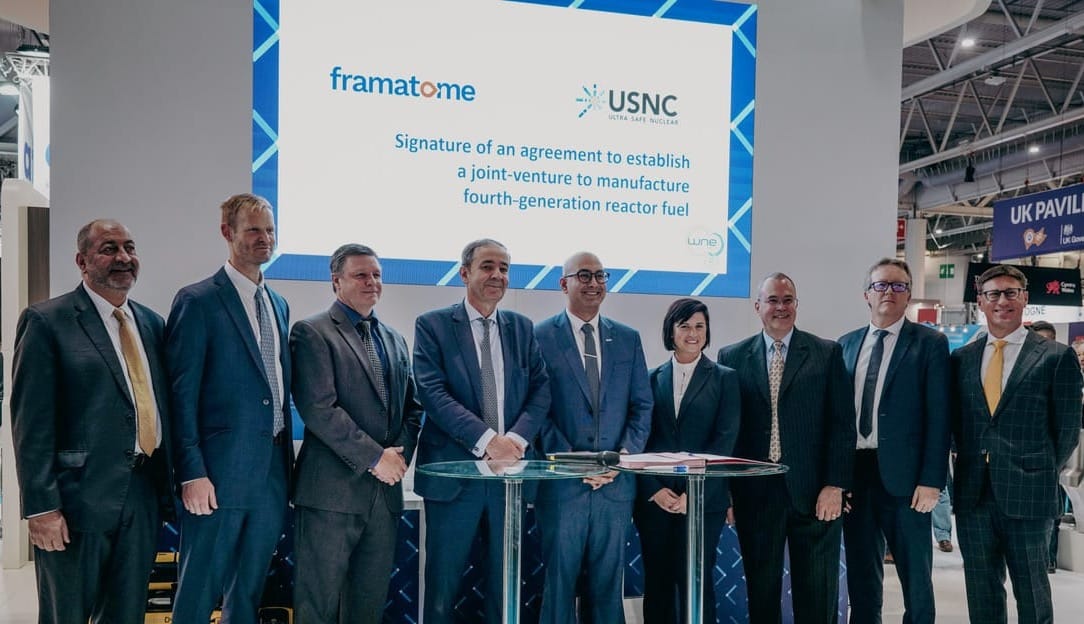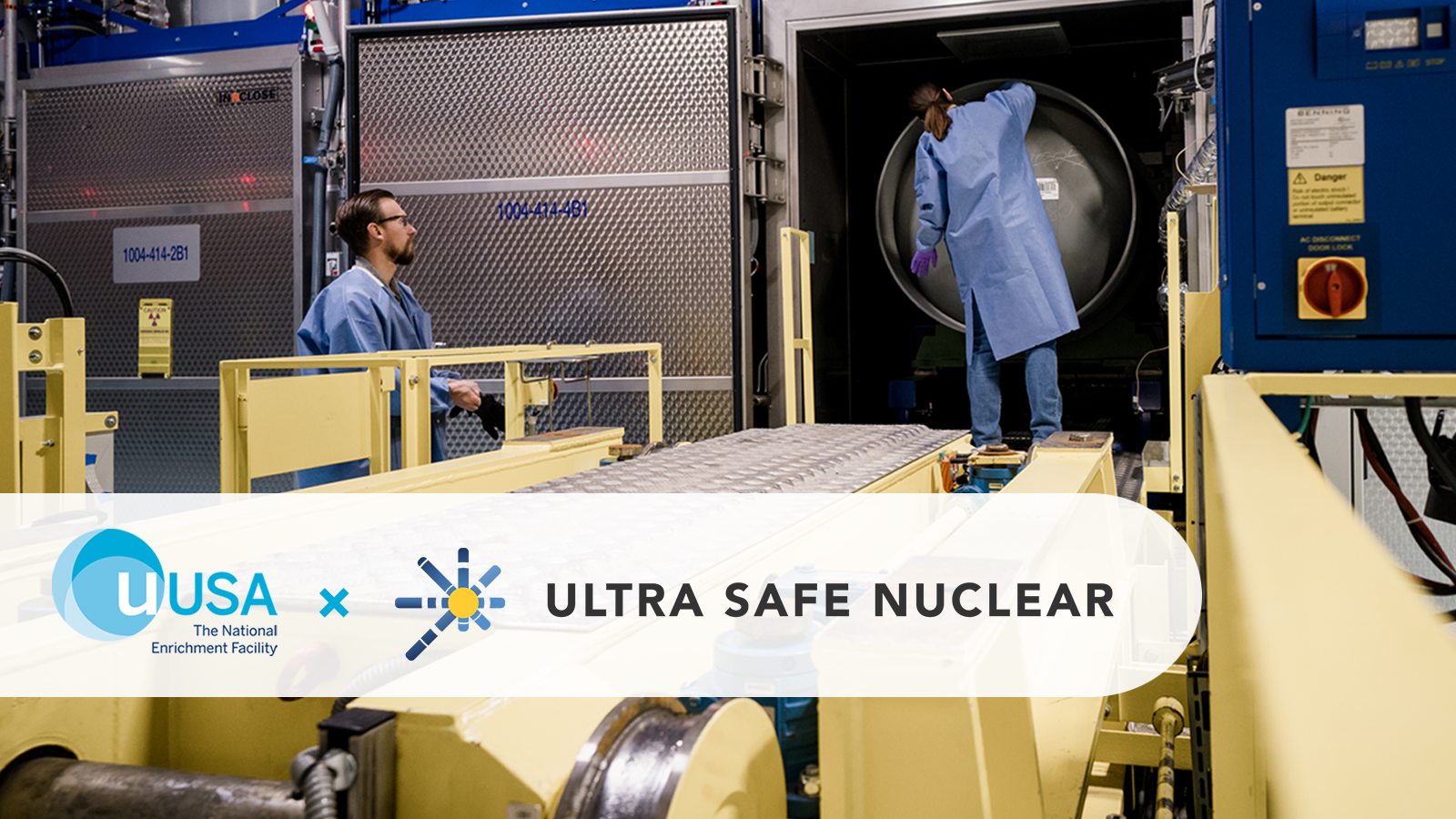TRISO / FCM® Fuel
Back to the Future
Built on TRISO
A Uranium bearing sphere is coated with special ceramic layers designed like tiny pressure vessels. The layers contain fission products inside and ensure mechanical and chemical stability during irradiation and temperature changes. This is called a TRISO Particle. Coated particle fuel was first developed for the Dragon Reactor in the UK in the 1960s, and follow-on gas reactors in Germany, the United States, Japan, South Africa, and China. The fuel is extremely robust, with over 60s years of development and experience.
The Role of Nuclear Fuel
As fission reactions take place, Uranium is slowly turning into roughly one third of the periodic table as solids and gases. These are the fission products, and they must be contained for they are radioactive and corrosive. So beyond generating fission heat, our fuel is made to contain and trap the fission products in place.
To do that, fuel must have good structural and chemical integrity and it must maintain its integrity across the encountered conditions; namely, power producing operations, worst case accidents, and in long-term storage. Generally, the material selection should aim to minimize properties like diffusion of fission products, chemical activity, thermal expansion, and swelling. Maximized properties are melting temperature, thermal conductivity, strength, hardness, and modulus.
Silicon Carbide Layer
The low radionuclide release rates from TRISO fuel particles result from the use of a 35-50 micron silicon carbide (SiC) coating layer around each 500-600 micron sized kernel of fuel. This provides each bit of fuel its own containment and pressure vessel allowing the fuel to contain fission products at very high temperatures and neutron bombardment.
SiC is an ideal nuclear material having excellent thermal and structural properties without affecting nuclear reactions. But SiC’s most significant advantage is its behavior under extreme irradiation and temperature. While most materials swell, transmute, and deteriorate to the point of crumbling, irradiated SiC converges to a quite acceptable equilibrium, even at ultra-high temperatures.
TRISO ULTRA
The management team responsible for making the fuel brings 200+ years of nuclear fuel processing and testing experience. In fact, we employ most of the same team that made high performance TRISO fuel for US DOE. Over decades, we've developed special techniques and knowledge to steadily improve the TRISO manufacturing process. We do not rely on any other commercial or governmental entity to make our fuel as we own the entire vertical chain of manufacturing from uranium feedstock to the final reactor core blocks.
Sphericity
Our perfected techniques allow for an extremely high yield and high performance TRISO particle. For example, we achieve the most spherical particles in the market, reducing stresses on the particle and enhancing particle performance.
Fuel Freedom
Our techniques allow for a wide variety of fuel types including Uranium Nitride (UN) and Uranium Oxy Carbide (UCO) as well as Thorium based fuel kernels. These advanced fuels allow for more flexible fuel cycles and more capable reactors.
Layer Freedom
The ceramic layers of a TRISO particle can be tuned and specified to achieve particular performance needs. For example, we can produce fuel particles with exotic ceramic layers of different thicknesses or porosities that are tailored for space applications.
TRISO + SiC Matrix
Fully Ceramic Microencapsulated (FCM®) Fuel is a new approach to inherent reactor safety by providing an ultimately safe fuel. Industry standard TRISO fuel, which contains the radioactive byproducts of fission within layered ceramic coatings, are encased within a fully dense silicon carbide matrix. This combination provides an extremely rugged and stable fuel with extraordinary high temperature stability.
Better Matrix
We’ve replaced the 60-year-old graphite matrix design with Silicon Carbide (SiC), a material used in tank armor that is phenomenally resistant to radiation and thermal damage, providing a dense, gas-tight barrier to trap fission products even if a TRISO particle should rupture. This strong barrier to fission product diffusion keeps the coolant very clean. Compared to the old graphite pellets, we expect FCM to keep the coolant extremely clean and improve tolerance of air and water ingress.
Higher Packing Fraction
FCM gets more fuel packed into the same volume than any other TRISO-based fuel. FCM can achieve packing fractions in excess of 60%, more than 50% greater than other TRISO-based fuel forms. This reduces enrichment needs and costs, enhances energy density, and ultimately lowers the proliferation burden of the reactor.
Better Process
FCM Fuel is manufactured in a low pressure process that protects the TRISO particles from compaction stresses found in other manufacturing methods. This also achieves a higher fuel packing fraction than conventional TRISO-based fuels.
Many Applications
FCM Fuel is compatible with helium coolant, but also molten salt and water coolants. It can be used in many types of reactors including molten salt cooled reactors, CANDUs, and LWRs. Standard TRISO is not compatible with water and has significant limitations for other applications.
Geometric Freedom
FCM is made through an additive manufacturing process. Optimal fuel element shapes can be made for the most efficient heat transfer and/or maximum safety.
Made for Storage
FCM is an ideal fuel form for long-term storage in spent fuel repositories. Unlike graphite, it has extremely low reaction rates with water and air and is stable for millions of years. FCM outlasts the fuel's radioactivity.
Extreme Performance
To make FCM Fuel, we start by additively manufacturing SiC shells in whatever shape we need - usually cylinders or annular cylinders. TRISO particles are then poured into the shell. Finally, SiC is deposited into the shell and between the particles to form a dense and robust matrix.
FUEL IN ANY SHAPE
Fully Ceramic Micro-encapsulated Fuel
Our manufacturing process allows for a wide variety of fuel shapes beyond simple pins. We can produce annular cylinders, hollow pebbles, Y-compacts and many other particular specifications.
Normal Fuel
FCM Fuel
Degrees of Failure
Full Containment
Fission Product Containment
None
Requires external cladding and containments
Fission Product Containment
Total
Containment built into the fuel pellet
Max Temperature
~400 °C
Tiny safety margins, electrical power only
Max Temperature
>1600 °C
Large margins and many applications
Chemical Compatibility
Low
Chemical Compatibility
Extreme
Cladding
Zircalloy
Exothermic hydrogen reaction with water
Cladding
None
No cladding, no hydrogen
Compatibility
Limited
Water-cooled reactors only
Compatibility
High
Can be used across reactor types
Spent Fuel
Normal
No change
Spent Fuel
Reduced
Volume and radioactivity reduced
Storage
Not Ready
Requires wet storage and repackaging
Storage
Ready
Form factor is ideal for long-term storage
Anti-proliferation
Normal
Normal proliferation concerns
Anti-proliferation
Excellent
Refractory Ceramic layers limit reprocessing
Additive SiC
3D print high-purity Silicon Carbide
We use the same suite of manufacturing technologies to 3D print customized components in highly pure, fully crystalline, and stoichiometric Silicon Carbide. Complex or simple parts for turbines or heat exchangers - we can do it all. Silicon Carbide offers extreme performance for many applications including nuclear reactors, aerospace, and defense. 3Dcarbide is the dedicated service website.
TRISO and FCM Fuel Pilot Line
Our Pilot Fuel Manufacturing Facility contains full scale production equipment for TRISO particles, FCM Fuel, and novel particle-based fuels and moderators. This is the only operating commercial-scale TRISO production facility in the Western world. Our privately owned facility is located in Oak Ridge, Tennessee on the Manhattan Project site previously occupied by the K-25 gaseous diffusion plant. In 2022, we produced the first Uranium bearing TRISO particles.
Factory
Factory development is underway with leading partners in the fuel and fuel supply industry. We are in the process of selecting a site.
Fueling MMR
The MMR Core is made up of several hundred Graphite Blocks with a few tons of FCM Fuel pellets (cylinders). The fuel provides best in class performance during operations as well as long term storage, outlasting the radioactivity of the spent fuel.
AVAILABLE NOW
TRISO particle fuel and custom fuel compacts are now available for purchase by approved buyers. Our fuels can be used in gas-cooled reactors, molten salt cooled reactors, CANDUs, and even LWRs to improve fuel performance. We also offer custom ceramic parts through 3dcarbide.com.
Related News
Framatome Inc. and Ultra Safe Nuclear Corporation execute an agreement to establish a joint venture to manufacture fourth-generation reactor fuel
November 28, 2023 – Framatome Inc. (Framatome) and Ultra Safe Nuclear Corporation (USNC) today signed an agreement to establish a joint venture (JV) at the World
USNC Boosts MMR Power, Flexibility, and Value
* A technology breakthrough in our patented FCM fuel allows a fuel geometry that results in both higher power and increased safety, enabling the MMR to
Urenco USA Will Supply Ultra Safe Nuclear Enriched Uranium Product for Advanced Reactor Deployment
Ultra Safe Nuclear Corporation will purchase enriched uranium product (EUP) from Urenco USA for use in the manufacture of Tri-structural Isotropic (TRISO) particles and Fully Ceramic Micro-encapsulated (FCM®) fuel via USNC’s planned joint venture with Framatome in the United States.



